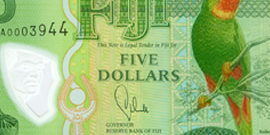The Reserve Bank of Fiji has announced the issue of the new $5 banknote into circulation from the 2nd April 2013.
It is the first banknote of the new “Flora and Fauna” design series which is to be released. As the old $2 banknote is now coined, it is also the lowest denomination banknote.
Most significantly, the design is now made from a polymer substrate. Reserve Bank of Fiji (RBF) Governor, Barry Whiteside, said the change from paper to polymer was a “significant step towards achieving greater banknote durability given the high usage of lower denomination banknotes and towards minimising currency acquisition costs”.
Low denomination banknotes in Fiji are exposed to “extreme wear and tear” according to the RBF and banknote durability was a key design criteria. Though it is thought to cost the bank twice as much to produce the polymer banknotes in comparison to paper, the notes are expected to last 3 times longer.
The new $5 banknote is green in colour, and was subsequently delayed in being released until the old green $2 banknote had been withdrawn from circulation to avoid confusion between the notes. The old $2 banknote ceased to be legal tender on the 31st March 2013 but members of the public can continue to return them to commercial banks in return for their value until the 30th April 2013, after which only the RBF can accept them.
Source: Reserve Bank of Fiji, various







